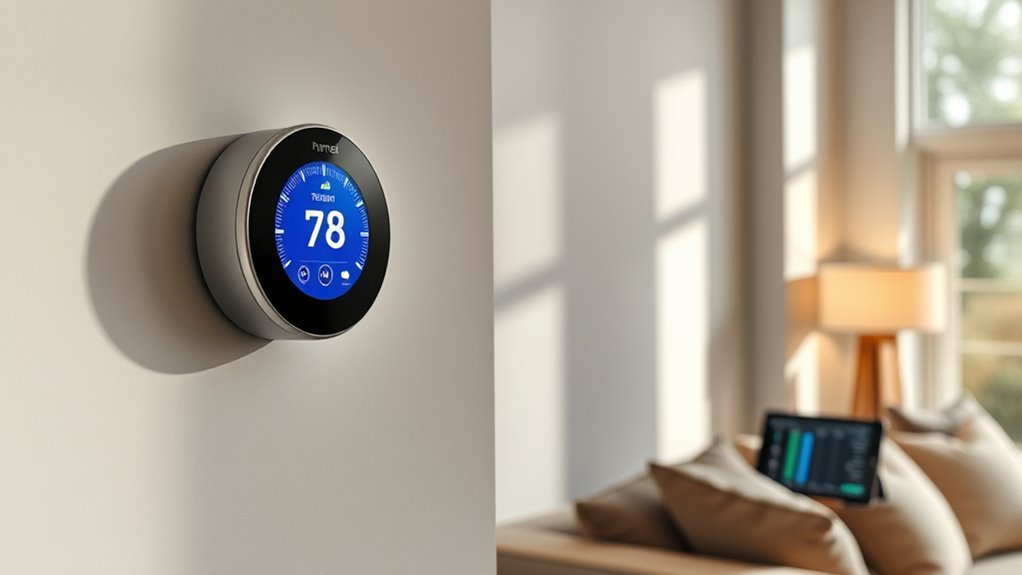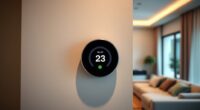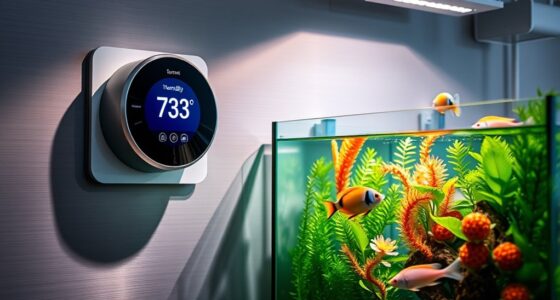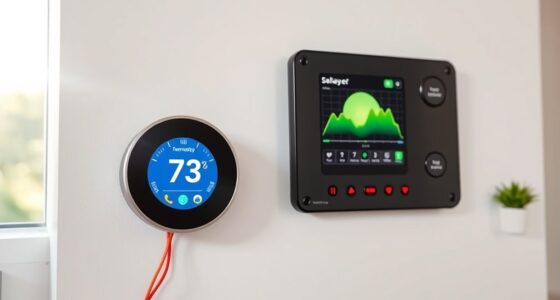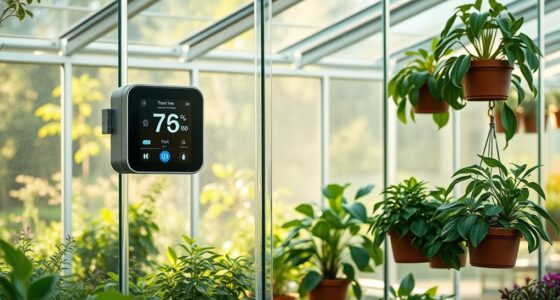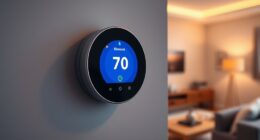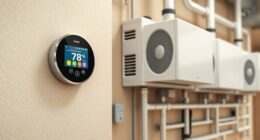By using your smart thermostat data, you can create routines that automatically adjust your home’s temperature based on your daily habits and schedules. This data helps your system anticipate when you’re arriving or leaving, optimizing comfort and energy savings without manual input. It also considers weather forecasts to precondition your space efficiently. Exploring how these insights can further improve your home’s performance can reveal even smarter ways to save energy and stay comfortable.
Key Takeaways
- Analyze occupancy and temperature data to create personalized routines that optimize comfort and energy efficiency.
- Use weather forecast insights to pre-adjust settings proactively, reducing energy waste.
- Automate temperature changes based on learned daily schedules and preferences for seamless comfort.
- Monitor energy consumption patterns to identify waste and suggest cost-saving adjustments.
- Continuously refine routines over time with adaptive algorithms, enhancing overall home energy management.
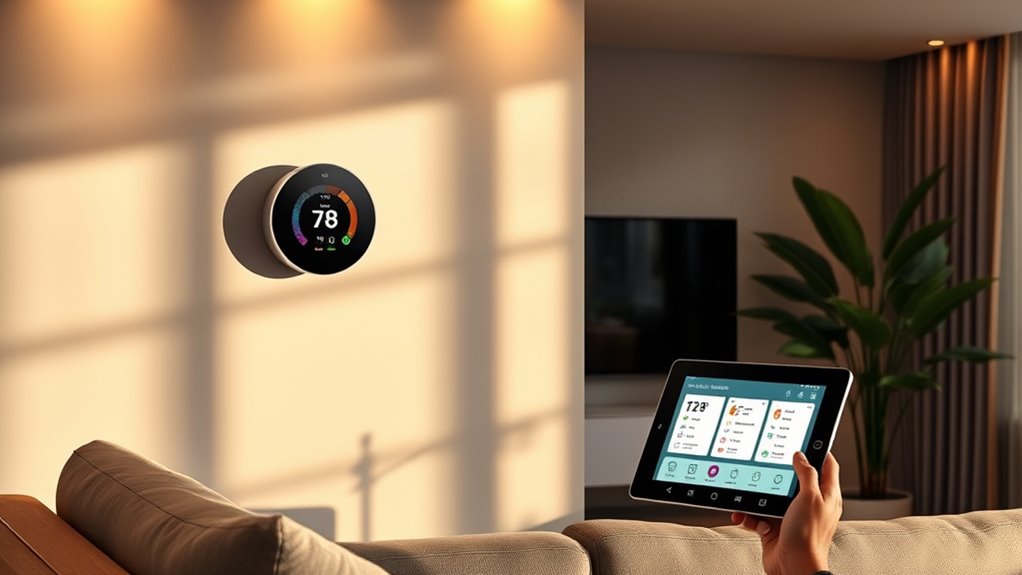
Have you ever wondered how smart thermostats optimize your home’s comfort and energy use? The answer lies in the smart thermostat data they collect and analyze daily. These devices monitor your heating and cooling patterns, adjusting settings to maximize energy efficiency while maintaining user comfort. By tracking when you’re home, asleep, or away, the thermostat learns your routines and makes intelligent decisions that save you money without sacrificing comfort. Additionally, many smart thermostats utilize advanced learning algorithms to improve their performance over time and adapt to changes in your schedule. Using smart thermostat data, you can create personalized home routines that respond automatically to your lifestyle. For example, if the data shows that you usually arrive home around 6 p.m., your thermostat can start warming or cooling the house just beforehand. This ensures you walk into a comfortable environment without wasting energy keeping it at a preset temperature all day. Over time, these routines become more refined, adjusting to changes in your schedule, weather, or preferences. This continuous learning process helps optimize energy efficiency by reducing unnecessary heating or cooling when you’re not home or during times when comfort isn’t a priority. Your smart thermostat’s ability to analyze data also enables you to set specific schedules based on occupancy patterns. For instance, if the data indicates that mornings are typically cooler or warmer than evenings, you can program the thermostat to adjust accordingly. This not only saves energy by avoiding overconditioning your home but also enhances user comfort by ensuring the temperature is just right when you need it. Many smart thermostats even integrate with weather forecasts, allowing them to preemptively adjust settings based on upcoming temperature changes, further improving energy efficiency and comfort. Additionally, smart thermostat data can reveal insights about your energy consumption habits, empowering you to make smarter decisions. If you notice that certain settings lead to higher energy bills without noticeable improvements in comfort, you can modify your routines or temperature preferences. Some systems even provide tips or alerts to help you reduce energy waste, such as suggesting lower temperatures during winter nights or higher temperatures during summer days. This feedback loop promotes a more energy-conscious lifestyle while keeping your home cozy. Moreover, understanding energy consumption habits can help you identify patterns that contribute to higher bills and make targeted adjustments. Also, being aware of resources and tools available can further assist in optimizing your home’s energy management. In essence, integrating smart thermostat data into your home routines creates a seamless balance between conserving energy and maintaining a comfortable environment. It allows your home to adapt intelligently to your habits, weather changes, and occupancy, making your living space more efficient and enjoyable. With ongoing data analysis, your smart thermostat becomes an active partner in creating a smart, energy-efficient home that responds precisely to your needs.
Frequently Asked Questions
Can Smart Thermostat Data Be Used to Predict Future Energy Consumption?
You wonder if smart thermostat data can predict future energy consumption. The answer is yes. By analyzing your usage patterns with predictive analytics, you can forecast how much energy you’ll need. This helps you optimize your home’s efficiency, save money, and reduce waste. As you gather more data over time, your smart system becomes better at predicting your future energy needs, making your home smarter and more energy-efficient.
How Secure Is My Smart Thermostat Data From Hacking?
Think of your smart thermostat data as a delicate piece of glass—you want to keep it safe. Its security depends on robust data encryption and your user consent. Manufacturers implement encryption to shield your info from hackers, but staying informed and managing permissions is vital. You should always review privacy settings and trust brands that prioritize security, ensuring your data remains as safe as a treasure chest behind a locked door.
Can I Integrate Smart Thermostat Data With Other Smart Home Devices?
You can definitely integrate smart thermostat data with other smart home devices, enhancing your automation capabilities. Check device compatibility first, ensuring your thermostat works with your existing smart home platform like Alexa or Google Home. Once compatible, you can create routines that adjust your heating or cooling based on your schedule, occupancy, or other device status, making your home more efficient and responsive to your needs.
What Privacy Considerations Exist When Sharing Thermostat Data?
When sharing thermostat data, you should consider privacy implications like data sharing and user consent. You need to guarantee that your data is only shared with trusted devices or platforms, and that you’ve given clear consent for its use. Always review privacy settings and policies, so you know who has access to your information. Protect your privacy by staying informed and controlling how your thermostat data is shared and used.
How Accurate Is the Data Collected by Smart Thermostats?
You might wonder how accurate smart thermostat data is. It’s generally reliable, thanks to regular sensor calibration that guarantees temperature readings stay precise. Additionally, data encryption protects your information from unauthorized access. While minor discrepancies can occur due to environmental factors, smart thermostats typically provide accurate data, helping you maintain comfort and energy efficiency. Regular calibration and encryption measures keep your data both precise and secure.
Conclusion
So, next time your smart thermostat starts judging your Netflix binge or midnight snacks, just remember—it’s not stalking, it’s optimizing. With all that data, your thermostat’s basically the Overlord of comfort and chaos. Embrace the irony: your smart home’s secretly smarter than you, making decisions while you’re busy ignoring the LED glare. Who knew your cozy nest was actually a data mine? Welcome to the future, where your thermostat’s got your number—and maybe, your sense of privacy too.
